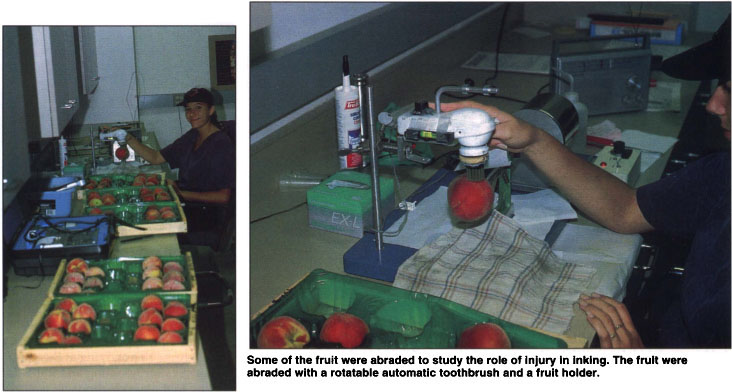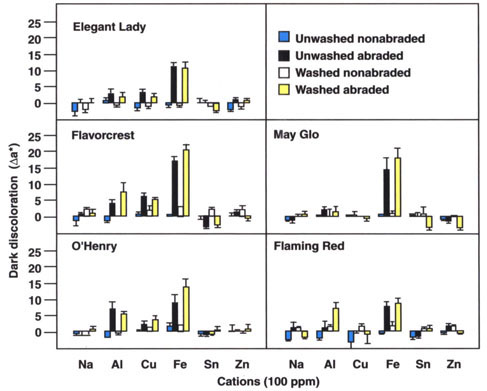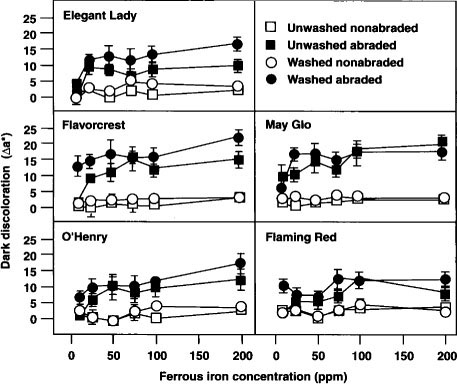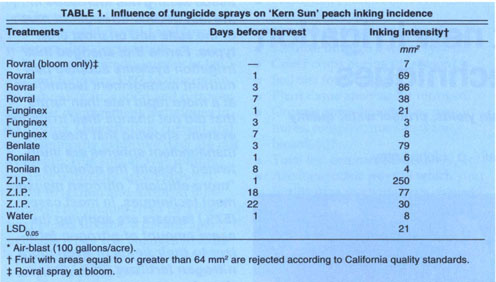All Issues
Contaminants and injury induce inking on peaches and nectarines
Publication Information
California Agriculture 53(1):19-23. https://doi.org/10.3733/ca.v053n01p19
Published January 01, 1999
PDF | Citation | Permissions
Abstract
After 3 years of study, we have demonstrated that physical injury combined with contamination cause skin discoloration, called inking, on peaches and nectarines. Abrasion damage releases anthocyanin/phenolic pigments, which are located in the skin cells, allowing the reaction of these pigments with the heavy-metal contaminants. We found that iron, copper and aluminum were the most deleterious contaminants of those studied in inducing inking on abraded fruit. Approximately 10 ppm iron was enough to induce inking at the physiological fruit pH (~3.5). This contamination can occur within 15 days before harvest, or during harvest or packing operations. Foliar-nutrient, fungicide and insecticide preharvest sprays may act as sources of contamination for inking development, depending on the preharvest application interval. To reduce inking incidence, we have developed safe preharvest application intervals that yield low inking incidence benomyl for iprodione (Rovral), triforine (Funginex), vinclozolin (Ronilan DF) (Benlate) and certain foliar nutrients containing heavy metals.
Full text
Inking on peach and nectarine fruits has become an increasingly frequent problem during the last decade in California, Washington, Georgia, South Carolina and Colorado. Inking, or skin discoloration, is also a problem in other production areas of the world including Italy, Australia, Argentina and Chile. Inking symptoms appear as discolored brown-and-black spots, and are restricted to the skin. Although inking affects only the fruit's cosmetic appearance, the disorder causes economic losses to the peach and nectarine industries each year because blemished fruit are not marketable. Through our previous anatomical studies, we learned that the type of physical injury associated with inking is abrasion (Crisosto et al. 1993). The damaged skin cells, where the anthocyanin/phenolic pigments are located, collapsed while the underlying fleshy cells (mesocarp cells) remained intact. Unfortunately, abrasion injury frequently occurs during harvest and hauling operations, and it is very difficult to eliminate.
As a follow-up to our previous work, we decided to determine where inking damage occurs during post-harvest handling operations, and if physical damage and/or exogenous contamination are related to its development. This information is fundamental to understanding inking development and for generating recommendations to reduce inking incidence for the stone fruit industry.
Inking occurrence during commercial harvest and postharvest handling was recorded on ‘Flavorcrest’, ‘Elegant Lady’ and ‘O'Henry’ peaches grown in an area with a history of inking, the Traver area of Tulare County. We collected samples on three harvest dates for each cultivar and at three handling points during harvest and transport: (1) directly from the tree and field-packed; (2) from bins, after bin filling and transport in the orchard to the loading point, approximately 4 miles; and (3) from bins arriving at the packinghouse (after handling and transporting to the packinghouse).
We took four replications of 18 fruit for each cultivar for each treatment. Fruit samples were picked at random from three trees selected previously and marked. Fruit were tracked during routine harvest and collected at the three locations noted. After collection, fruit samples were carefully placed in tray packs, padded and packed in the orchard or packinghouse before being transported to the UC Kearney Agricultural Center (KAC) for subsequent inking evaluation.
Effects of pH and metallic ions
We randomly picked ‘Flavorcrest’, ‘Elegant Lady’ and ‘O'Henry’ peaches, and ‘May Glo’ and ‘Flaming Red’ nectarines at commercial maturity according to ground color from orchards at or near the KAC. The fruit were carefully handled to avoid physical damage. We separated 20 fruit from each of five randomly selected trees (replications) per cultivar into two main treatments (50 fruit each), unwashed (UW) and washed (W). Washed fruit were submerged in tap water for 5 minutes, rinsed with distilled water (dH2O) and placed on clean paper towels to air-dry.
The purpose of the washing treatment was to remove metallic ions and/or other contaminants from the fruit surface. Each treatment was applied to nonabraded fruit (NA) and abraded fruit (A). The fruit was abraded with a rotatable automatic toothbrush and a fruit holder. The fruit holder was a modified apple peeler, which allowed forward and backward movement of the fruit during reversible rotations. During abrasion, the fruit was hand-rotated forward and then backward (one cycle) while the automatic toothbrush head abraded the skin; the cycle was done three times with the initial toothbrush head positioned 0.5 cm apart from the previous one, to maximize uniform abrasion. The hand-rotation speed was kept as consistent as possible for all fruit samples.
Some of the fruit were abraded to study the role of injury in inking. The fruit were abraded with a rotatable automatic toothbrush and a fruit holder.
In each subtreatment — abraded and nonabraded — fruit were randomly sampled for preparation of skin disks. Six skin disks were used for each of the different pH and ion applications. The disks were sampled from the red-colored surface of the fruit, either nonabraded or abraded, using a cork borer (44 mm2 inner area). The disks were randomly placed on a piece of cardboard covered with a paper towel. Each disk was identified by the layout order during the following experiments. After measuring the color with a Minolta Colorimeter CR 200 in the L*a*b* color-notation system (C illuminant, calibrated with standard white plate, and 0° viewing angle), we placed the skin disks in the treatment solutions (30 mL). Air bubbles on the skin-disk surface were removed by stirring gently. For pH treatments, solutions of pH 3, 4, 5, 6, 7, 8 and 9 were prepared with phosphate buffer (0.1M).
For ion treatments, solutions of sodium, aluminum, ferrous-iron, copper, tin and zinc ions were prepared in a final ion concentration of 100 ppm in dH2O. For iron-concentration treatments, ferrous-iron solutions were prepared in ion concentrations of 10, 25, 50, 75, 100 and 200 ppm. Ion compounds used were all in chloride-salt form for uniformity and all solutions were prepared daily. Solutions of 100 ppm bicarbonate or nitrate were also used. The control solution was dH2O and an untreated check was used for abraded and nonabraded subtreatments.
After a 15-minute incubation period, the disks were taken out, blotted with Kimwipes, and air-dried for 1 minute, then the color was measured again. Discoloration was expressed by the relative change in the color value a*, as Δa*, since it amply reflected the visual darkening on the skin disks. The Δa* was calculated as the difference between the a* before treatment and the a* after incubation. The higher value of Δa* reflected a darker discoloration.
Preharvest chemical sprays
We chose ‘Fantasia’ and ‘Flaming Red’ nectarines, and ‘Kern Sun’, ‘Flavorcrest’, ‘Elegant Lady’, ‘O'Henry’, ‘Summer Lady’ and ‘Cal Red’ peaches for our preharvest chemical spray experiments. Fungicides and foliar nutrients commonly used by the California stone-fruit industry were selected and applied to entire trees according to label instructions.
At least eight trees per cultivar were used as replicates for each treatment, except for ‘Kern Sun’ and ‘Cal Red’ where 25 trees per replicate were used and four rows were left as a buffer between treatment-replicates (approximately 6-acre plot). All of the fungicide and foliar-nutrient sprays were applied using an air-blast sprayer (approximately 100 gal/acre). Z.I.P. (2 qt/acre/100 gal) was applied 1, 18 and 22 days before harvest (DBH); Rovral (0.5 lb/100 gal) and Funginex (12 oz/100 gal) were applied 7, 3 and 1 DBH; Benlate (2 lb/100 gal) and Ronilan DF (0.5 lb/100 gal) were applied 4 and 14 DBH, respectively. Fruit located in the outer canopy were harvested at commercial maturity. Harvesting was done using picking bags, followed by dumping in wooden bins, and transport on trailers to the KAC's F. Gordon Mitchell Postharvest Laboratory. Four boxes of approximately 60 fruit each (volume filled) were hand-packed from each tree (replicate). These boxes were labeled, room-cooled, and kept in cold storage for later inking evaluation.
Samples from each spray solution used in our experiments were sent out for commercial analysis for iron, copper, aluminum and tin.
Inking evaluation
In all experiments, fruit samples were placed in a room controlled at 68° F (20° C) and 80% relative humidity for 2 to 3 days before inking evaluation. We determined inking by two methods. The first method was by percentage of individual fruit with inking symptoms (incidence). The second was by an aggregated inking index (AII) based on measurements of total fruit surface area affected by inking (intensity). All was measured using a 0.9 cm diameter loop; a larger discolored area was counted as two or more, accordingly. The percentage of cull fruit was calculated based on the California Quality Standards (USDA 1987), which states that any fruit presenting a discolored area ≥0.9 cm in diameter should be rejected.
Average incidence of inking increased dramatically with fruit handling after harvest (fig. 1). High inking levels were detected on fruit sampled during harvest as well as before and after fruits were transported to the packinghouse. Inking incidence on fruit picked directly into tray packs and transported gently to KAC was 42%, 42% and 29% for ‘Flavorcrest’, ‘Elegant Lady’ and ‘O'Henry’, respectively. Inking incidence before and after transport to the packinghouse was nearly 100%. High cull levels, up to 40%, were measured after transport within and out of the orchard on ‘Flavorcrest’, ‘Elegant Lady’ and ‘O'Henry’ peaches. Fruit picked directly from the tree and field packed (tree) had 17% culls.
Skin disk responses
Dark discoloration did not develop on skin disks of nonabraded fruit either unwashed or washed when exposed to pH solutions from 3 to 9 in all peach and nectarine cultivars tested (fig. 2). On abraded skin disks from unwashed and washed fruit, the redness intensified after incubation in a buffer of pH 3, especially on those from the cultivars ‘May Glo’, ‘Flavorcrest’, ‘O'Henry’ and ‘Elegant Lady’. Treatment in buffers of pH 4 and 5 did not markedly change the Δa* of skin disks in any of the cultivars examined. On skin disks from ‘Flavorcrest’, ‘Elegant Lady’ and ‘O'Henry’ peaches, some discoloration started to occur in a buffer of pH 6. In buffers of pH 7,8 and 9, dark discoloration of various degrees developed on the abraded skin disks of all of the cultivars (fig. 2). The washing treatment induced significant dark discoloration only on abraded ‘May Glo’ and ‘Flaming Red’ nectarines. Abrasion treatment significantly increased the development of dark discoloration in all of the tested cultivars (data not shown).
A significant interaction between washing and abrasion on dark-discoloration formation was determined. The UW-NA and W-NA combinations showed no dark-discoloration formation; however, the abraded fruit with or without washing displayed high levels of dark discoloration. The W-A treatment yielded the highest dark-discoloration formation among all of the cultivars. This may be explained due to an increase in abrasion susceptibility by immersing fruit in water prior to our low-level abrasion treatment. Disappearance of the dark discoloration caused by high-pH buffers was noticed a few hours after the skin disks were removed from the buffers. An experiment was conducted to monitor the posttreatment change in skin color using skin disks from washed fruit of ‘Cal Red’ peaches and ‘Flamekist’ nectarines. The results indicated that the dark discoloration caused by high pH gradually disappeared after about 3 to 5 hours, leaving red to light-brown spots. Thus, exposing fruit to clean water during hydrocooling and/or washing does not induce inking.
Fig. 1. Influence of harvest operations on percentage with inking and percentage of culls of ‘Flavorcrest’, ‘Elegant Lady’ and ‘O'Henry’ fruit collected at harvest: (1) directly from the tree and field-packed (tree), (2) after bin filling and transport in the orchard to the loading point (orchard), and (3) after handling and transport to the packinghouse (packinghouse). Each value represents an average of three cultivars using four replications of 18 fruit each. Vertical bars represent standard error.
Fig. 2. Development of dark discoloration of peach and nectarine fruit skin disks in various phosphate-buffer pH solutions. Vertical bars represent standard error.
Fig. 3. Dark discoloration of peach and nectarine fruit after 15-minute incubation in metallic-ion solutions (dH2O, pH 3.5). Vertical bars represent standard error.
Fig. 4. Change in color (Δa*) of skin disks from peach and nectarine fruit in response to different iron concentrations of solutions. Vertical bars represent standard error.
Metallic-ion solutions
On skin disks from NA fruit, whether washed or unwashed, no dark discoloration was observed after any metallic-ion 100-ppm-solution treatments in all of the cultivars, except copper on ‘May Glo’ and ‘Flaming Red’ (fig. 3). On skin disks with or without washing, ions of iron, aluminum and copper caused evident discoloration (fig. 3). The discoloration caused by iron and aluminum ions was black. Of the metallic-ion solutions tested, iron caused the most severe discoloration. Sodium-, stannous-or zinc-ion solutions had little effect on the Δa* of the skin disks (fig. 3), as did bicarbonate and nitrate solutions. With iron, skin disks from fruit of ‘May Glo’ and ‘Flavorcrest’ developed more discoloration than those of ‘Elegant Lady’, ‘O'Henry’ and ‘Flaming Red’. The skin disks of ‘Flavorcrest’ and ‘O'Henry’ fruit showed more discoloration than other cultivars when treated with aluminum. The dark discoloration caused by iron and aluminum did not fade for at least 4 days. Thus, hydrocooling abraded fruit with water containing heavy metals may be inducing inking.
Since iron was the most effective ion in causing skin discoloration, a concentration effect was investigated. Iron solutions of 10 to 200 ppm did not cause discoloration on skin disks of NA fruit with or without washing treatment of any cultivars after 15 minutes of incubation (fig. 4).
With abraded disks, an iron concentration as low as approximately 10 ppm caused dark discoloration in all the cultivars tested. The Δa*s on skin disks of W-A fruit were generally higher than those of UW-A fruit. Iron concentrations of >50 ppm resulted in no significant change in the a* value.
Preharvest sprays
‘Kern Sun’ peach inking intensity was highest on fruit from the Benlate 3 DBH, Rovral 1 and 3 DBH and Z.I.P. 1 and 18 DBH treatments (table 1). The Rovral 7 DBH, Ronilan [[1 and 8 DBH, Funginex 1, 3 and 7 DBH, and Z.I.P. 22 DBH treatments did not induce any commercially important inking development on peach fruit from ‘Kern Sun’. Non-abraded fruit did not present inking symptoms in any of these treatments. Fruit from the commercial treatment (Rovral applied at bloom time) did not exhibit any commercially significant inking (table 1). The role of fungicides acting as contaminants in inking incidence has been demonstrated in our previous trials.
High iron, aluminum and copper, and low tin concentrations were detected in most of the pesticides analyzed in these studies (table 2). High iron (1,930 to 2.5 ppm) and aluminum (3,920 to < 5.0 ppm) concentrations were measured in phosmet (Imidan 50WP), thiophanate-methyl (Topsin M), Benlate, Rovral, Bacillus thuringiensus var. Kurstaki (DiPel 2x) and systhane (Rally). Foli-Cal, Funginex, Rally and Topsin M had copper concentrations ranging from 1,960 to 6.95 ppm. Tin levels were usually below 5 ppm in most of the chemicals analyzed.
Recommendations
Based on these experiments, we developed the following recommendations to help growers reduce inking problems.
1. To reduce abrasion damage, handle fruit gently, avoid long hauling distances and keep harvest containers free of dirt.
2. Contamination of fruit can be reduced by keeping harvesting equipment clean; avoiding dust contamination on fruit; checking water quality for heavy-metal (iron, aluminum and copper) contamination; and avoiding foliar-nutrient sprays containing heavy metals within 22 days before harvest (unless there is a deficiency). We developed the following tentative preharvest application intervals: foliar nutrients containing heavy metals = 22 DBH, Benlate = 12 DBH, Rovral = 7 DBH, Funginex = 3 DBH and Ronilan = 1 DBH.
3. In case of a possible inking situation with peaches and/or nectarines, delay packaging for 48 hours to detect fruit inking damage during grading.
4. As a short-term solution, we suggest that chemical manufacturers (foliar nutrients, fungicides and insecticides) develop preharvest application intervals to avoid inking.
5. As a long-term solution, we suggest that chemical manufacturers attempt to identify and remove possible sources of contamination from products that may contribute to inking.












